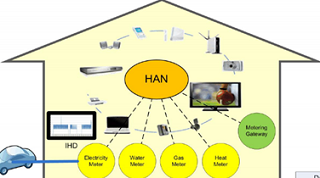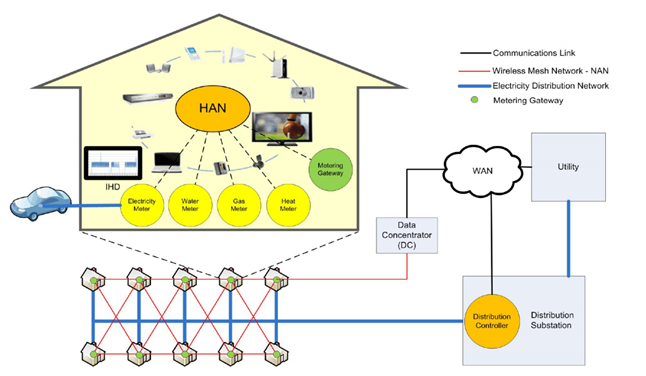From 2GreenEnergy Intern Fabio Porcu: Architecture of the Smart Grid

• Smart Metering
• HAN: Home Area Network
• Metering Gateway
• NAN: Neighborhood Area Network
• Data Concentrator (DC)
• WAN: Wide Area Network
• Distribution Controller
• Utility
Smart Metering is the main tool in the implementation of the Smart Grid because this device allows two-way communication. As shown here, smart meters are positioned within the dwelling and measure the consumption of electricity, gas, water and heat.
All smart metered homes are linked together in a HAN (Home Area Network) and transmit the data they collect to the metering gateway. This device has the task of forwarding data packets received from the various smart meters to a NAN (Neighborhood Area Network). The NAN collects data from multiple HANs to send them to a data concentrator, which organizes all received data in the database according to a very precise standard format. At this point a WAN (wide area network) collects the data from the formatted data concentrators and redistributes them to control centers or to the appropriate utility.
From all this, it is clear that a key feature of the smart grid is the interconnection of a potentially large number of consumers, networks, and utilities, and, at the same time, the grid operators and power generators. Many communication technologies can co-exist within the same system, thus it is indispensable that communication standards exist, enabling all devices to communicate with each other.
The table below shows some of the transmission technology that are used depending on the type of network and the breadth of the territorial network.
| Type of network | Range | Data Rate requirement | Potential technologies |
| HAN | Tens of meters | Application dependant but generally low bit rate control information | ZigBee, Wi-Fi, Ethernet, PLC |
| NAN | Hundreds of meters | Depends on node density in the network (e.g. 2 Kbps in the case of 500 meters sending 60 byte metering data every 2 minutes per NAN) | ZigBee, Wi-Fi, PLC, cellular |
| WAN | Tens of kilometers | High capability device such as a high speed WiMax, 3G/LTE, router/switch (a few hundred Mbps to a few Gbps) | Ethernet, microwave, WiMax, 3G/LTE, fibre optic links |
It can be expected that in complex systems such as smart grids, communication technologies are used to meet the different needs of the heterogeneous system. Therefore, the main objective of hardware and message formats standardization for smart grids is to ensure interoperability and compatibility between the different components of the system (meters, devices or protocols).
The success of energy distribution through smart metering and smart grid networks will depend on the availability of mechanisms and standards that enable consumers and providers to interface and interoperate in an effective way in order to solve problems for which this technology is born.
A smart grid has access to real-time information on the flow of energy, and enables more intelligent management by both the supplier of energy and the consumer. Furthermore, the possibility of a real-time detection of consumption allows detection of damage, failure or even theft of energy. Smart metering and smart grid are spreading rapidly in many parts of the world, but the technology used for data communication varies greatly, depending on geographical, economic, political and social factors. There are many governments and companies interested in this technology for various reasons, so a regulatory body and legislature that defines guidelines and standards and ensures the integration of all devices in a single system is important.

